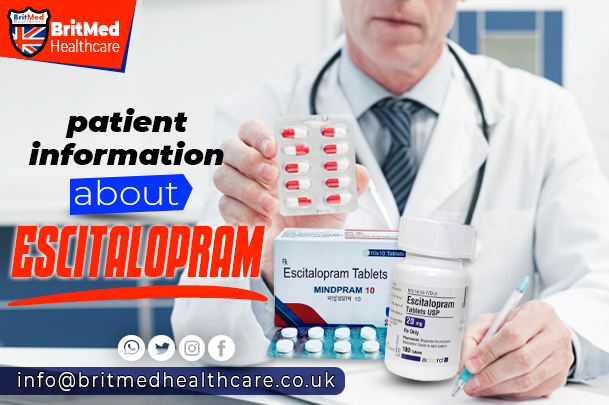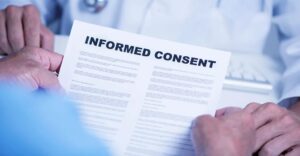Escitalopram
Escitalopram is the pure form of Citalopram, an antidepressant that functions as a selective serotonin reuptake inhibitor (SSRI). Similar to our left and right hands, which are mirror images of each other but in the opposite direction, citalopram contains two mirror-image forms, known as S and R forms. The S form is the only one found in escitalopram. What benefit is there of citalopram against escitalopram? The S form is assumed to have the main antidepressant function, whereas the R form may interact with the active molecule and cause adverse effects in addition to having little or no antidepressant effectiveness. Based on clinical study results, it is believed that escitalopram, which solely contains the refined S form, has more antidepressant effectiveness than citalopram and has fewer adverse effects.
The Food and Drug Administration (FDA) of the United States has authorized escitalopram
for the treatment of major depressive disorder and general anxiety disorder. in clinical practice Lexapro is used for unapproved purposes to treat several mental conditions, including as obsessive-compulsive disorder, Premenstrual dysphoric disorder, panic disorder, social anxiety disorder, and posttraumatic stress disorder.
Escitalopram is a serotonin-specific drug that increases brain levels of the neurotransmitter serotonin by preventing its absorption back into brain cells. Depression and other mental diseases have been associated with low serotonin levels. This abnormality may cause changes in affected brain parts which might result in psychological symptoms including depression or anxiety. Escitalopram and other SSRIs are known to increase serotonin levels, which may aid in the restoration of normal function to particular areas of the brain.
What is the recommended dose of Escitalopram
The standard beginning dose of escitalopram for depression and generalized anxiety disorder is 10 mg once day, either in the morning or the evening. If after three to four weeks there is still no improvement, the dose can be raised to 20 mg once day. Most individuals require a dose of 10–20 mg per day to cure depression. however, some Higher doses can be necessary for those whose depression is more severe. Doses greater than those used for depression may also be necessary for the treatment of other mental illnesses. the lower maintenance dosage of 10 mg/day as well as a lower initial dosage of 5 mg/day may be necessary for elderly patients and those with serious or long-term medical conditions. There is a liquid version of escitalopram available for those who are unable to swallow tablets.
It might take up to 2-4 weeks for the majority of people to feel the full benefits of the medicine. The length of a person’s pharmaceutical therapy is determined by their family history and own psychiatric history. For example, the duration of drug therapy will be greater for individuals who have experienced two or more prior periods attributed to serious depression. in 6 months, the drug may be reduced for the majority of patients. Tiny proportion of individuals may experience persistent depression symptoms even after their antidepressant dosage is lowered or discontinued. For a year or more, these people could benefit from continuing to take escitalopram.
What happens when you take an overdose of Escitalopram
Like other SSRIs, escitalopram is far less dangerous to use in excess than some of the more recent antidepressants and the older tricyclic antidepressants. The bulk of deaths from recorded escitalopram overdoses occurred when the drug was combined with alcohol or other drugs. However, there have been many reports of deaths when escitalopram was used alone it was used in extremely large dosages.
Treating any suspected overdose as an emergency is imperative. The individual has to be brought to the emergency space for care and observation. It is advisable to include both the prescription bottle of medication and any other medication suspected in the overdose, since the information on the label can be useful in helping the treating physician figure out how many tablets the patient has taken.
What are the common side effects of Escitalopram
The most often reported gastrointestinal disturbances associated with escitalopram are nausea, vomiting, indigestion, diarrhea, and loose stools. Anxiety, jitters, and difficulty falling asleep are other often adverse effects that were reported. On rare occasions, people may feel drowsy, sweat excessively, and have headaches. Unlike some other SSRIs like Paxil, escitalopram has relatively little effect on changes in appetite and weight.
Sexual dysfunction can be brought on by escitalopram in both men and women. Men’s and women’s delayed ejaculation and delayed orgasm are the reported sexual adverse effects. Some persons could feel less interested in engaging in sexual activities or have less desire to do so. But compared to Prozac or Paxil, the negative effects on sexual function associated with escitalopram are often less common.
What is the effect of Escitalopram on Pregnancy and Lactation
Escitalopram is pregnancy category C. There are no studies done on women to determine escitalopram’s safety during pregnancy. It is not accurate how the drug will affect a growing fetus in a pregnant woman. But late in the third trimester, newborns exposed to antidepressants like SSRIs experienced difficulties that necessitated extended hospital stays, breathing support, and tube feeding. Women who are or may become pregnant should contact with their doctor about this. When they stop taking their antidepressant, some women may have a relapse of depression.
In these certain situations, it can be essential to resume taking the medicine or look for a different kind of drug or treatment. escitalopram should not be taken by nursing moms since minute quantities may enter breast milk and be consumed by the infant. Breastfeeding should not begin or should be stopped if quitting the medication is not an option.
What are the precautions taken while using Escitalopram
Some people may become sleepy after using escitalopram. patients should refrain from using machinery or driving till they are certain that the drug have no effect on their attention. Individuals who have a documented allergy to escitalopram or who have taken it and had a serious side effect shouldn’t use escitalopram.
Major depressive disorder may often be effectively treated with medication, psychotherapy, or both. When treating moderate to severe depression, the combination of psychotherapy and antidepressants is particularly successful. While treatment builds coping skills, the drugs enhance mood, appetite, sleep, energy, and overall health, addresses any potential underlying problems and enhances behavior and mental habits.
the majority of patients who take antidepressants claim feeling better overall. Most people don’t notice any therapeutic effects from their medications until about 3–4 weeks and it might sometimes take as long as that. minority of people may notice some improvement by the end of the first week. It takes 8 weeks for the drug to have full effect. it is crucial that patients take their antidepressant for the whole recommended amount of time and that they do not give up and stop taking it too soon if they do not start feeling better right away.
Antidepressants have been shown in short-term trials to raise the likelihood of suicide thoughts and actions in children and adolescents with major depressive disorder and other mental diseases. When initiating antidepressant medication in children and adolescents, the FDA mandates that the doctor disclose this risk. The FDA found that there is an age-related risk of suicide thoughts and actions when using antidepressants. This occurrence is more likely to happen early in the course of therapy and is more common in younger populations. Antidepressant use did not seem to be associated with a higher incidence of suicidality in people over the age of 24, as compared to placebo use. The results demonstrated that antidepressants protected against suicide thoughts and actions in people over the age of 65.
According to other research, there is a decrease in suicide rates in communities where a higher proportion of the population uses antidepressants. Suicide risk is a part of depression and may not go away until the patient responds to therapy. Upon initiating or modifying antidepressant therapy, the individual particularly if they are a child or adolescent should have continuously monitored for growing symptoms of depression, and any concerns should be reported to the doctor by the caregiver or family.
If you have suicidal thoughts, you should always tell your doctor or a family member. Notify your family doctor or psychiatrist if you feel like you can’t manage suicide thoughts or desires, or if your depression symptoms get worse. Avoid stopping escitalopram suddenly. Your dosage should be tapered gradually to prevent discontinuation symptoms.
If you forget to take a dosage, make sure to catch up by taking it two to three hours later than usual. If the next planned dosage is approaching, skip the missed one and go on with your usual dosing regimen.
- Avoid taking two doses at once.
- You can take escitalopram with or without meals.
- Keep the medication out of direct sunlight and dampness in the light-resistant container that came with it. Your drug may break down more quickly in hot and humid environments, losing its therapeutic benefits.
- Make sure kids can’t get to your medicine.
What are the possible drug interactions with Escitalopram
Because one medicine may change the other’s blood levels, using escitalopram with some other drugs may have unfavorable drug interactions. Thankfully, escitalopram has a decreased frequency of documented medication interactions compared to paroxetine or fluoxetine among other SSRIs.
Escitalopram may cause bleeding by raising the levels of warfarin and its anticoagulant effects. Compared to other SSRIs, this interaction is less likely to occur. However, when beginning any SSRI, thorough monitoring is necessary when on warfarin medication. The erythromycin class of antibiotics may raise blood levels of escitalopram and raise the risk of negative side effects.
Cimetidine may raise blood levels of escitalopram and raise the risk of negative side effects. Antifungals may raise escitalopram blood levels and raise the risk of negative side effects.
When escitalopram is taken with other drugs, including herbal supplements like St. John’s wort, that increase serotonin may result in high amounts of that neurotransmitter and cause a hazardous state called serotonin syndrome. Serotonin syndrome’s initial symptoms include tremors, flushing, restlessness, and bewilderment. and uncontrollably jerking muscles. Should the medicine not be discontinued, the patient may experience further potentially fatal side effects such as muscular weakness, elevated body temperature, breathing difficulties, blood coagulation issues, and red blood cell decomposition, which might result in abrupt renal failure. Escitalopram users should be aware of the potential symptoms of serotonin syndrome, which call for stopping the serotonin-boosting drugs and seeking emergency medical assistance.
Monoamine oxidase inhibitors (MAOIs), an antidepressant class, should not be taken with escitalopram as this combination may cause a dangerous reaction that includes elevated body temperature, high blood pressure, along with a great deal of excitement and anxiety. Patients should consult their doctor or pharmacist before starting any new medications, including OTC medications and herbal supplements, while taking escitalopram.




